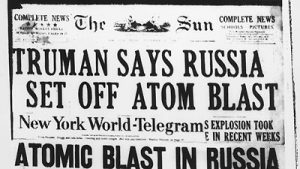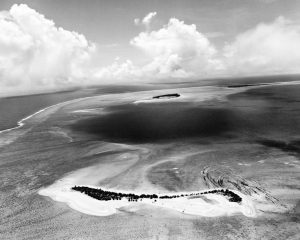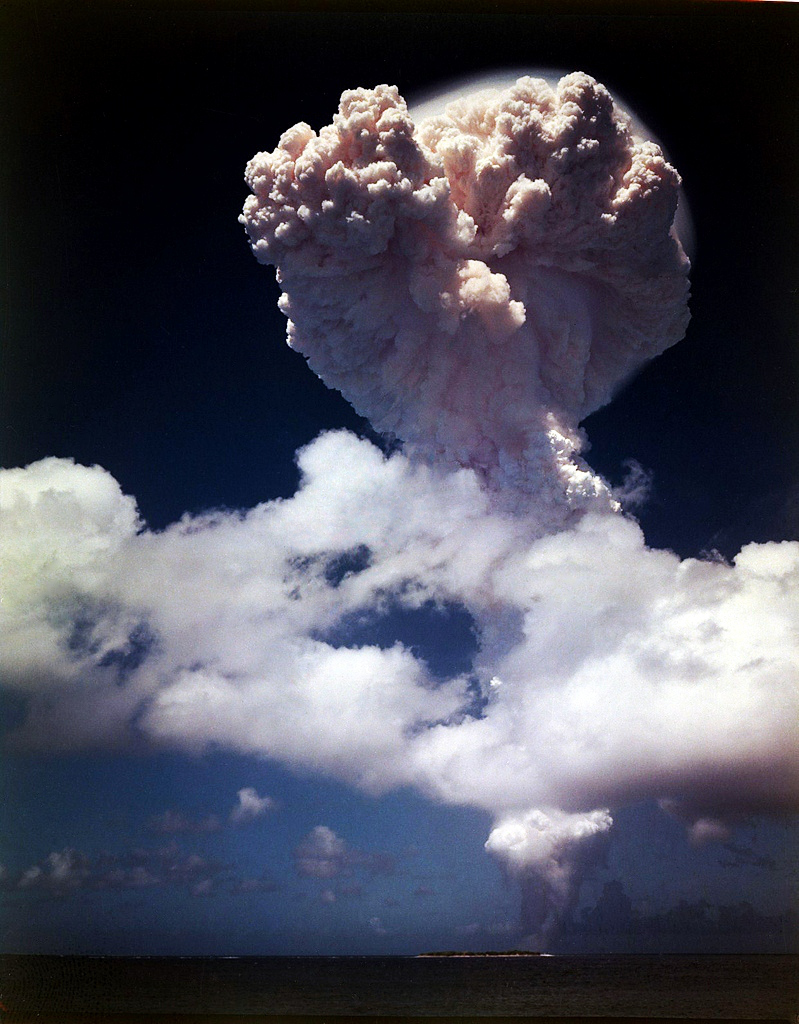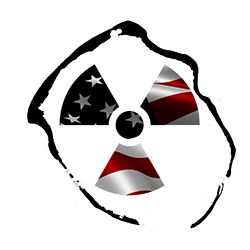Operation Ivy
 On January 31st, 1950 Pres. Truman publicly declared that the U.S. intended to develop a hydrogen bomb. Two things spurred Truman to this declaration. One was the first test of a fission device by the Soviet Union in the fall of the previous year, an event that took everyone by surprise. The second, related to the first, was the discovery of the British scientist Klaus Fuchs’ espionage while a member of the Trinity team at Los Alamos. Fuchs was a German-born physicist with communist leanings who fled Germany in 1933. By 1941 he had joined the British Tube Alloys program which had an early jump on atomic weapons development but, in the midst of the war, had run up against budgetary constraints; Britain was severely strapped for cash. It’s believed that Fuchs was already passing this research to the Soviets at this point.
On January 31st, 1950 Pres. Truman publicly declared that the U.S. intended to develop a hydrogen bomb. Two things spurred Truman to this declaration. One was the first test of a fission device by the Soviet Union in the fall of the previous year, an event that took everyone by surprise. The second, related to the first, was the discovery of the British scientist Klaus Fuchs’ espionage while a member of the Trinity team at Los Alamos. Fuchs was a German-born physicist with communist leanings who fled Germany in 1933. By 1941 he had joined the British Tube Alloys program which had an early jump on atomic weapons development but, in the midst of the war, had run up against budgetary constraints; Britain was severely strapped for cash. It’s believed that Fuchs was already passing this research to the Soviets at this point.
A deal was struck whereby the Americans and British would team up and share the research. Fuchs traveled to Columbia University as part of the British contingent, to work on the Manhattan Project. It’s debatable how useful the information he provided was to the Soviets but they were certainly able to forego years of research on certain aspects of bomb design as a result. He was sentenced to 14 years but served just nine years, four months with time off for good behavior. Upon release, he immediately emigrated to Soviet East Germany, where he would spend the remainder of his life. He died in Berlin in 1988.

It’s impossible to talk about the hydrogen bomb without coming slap-bang up against Edward Teller, theoretical physicist, friend of Enrico Fermi’s and member of Robert Oppenheimer’s team at the Manhattan Project. Teller was a Hungarian-born Jew who studied in Germany before fleeing at the beginning of the war, eventually ending up in Chicago, where he befriended Fermi. Almost as soon as it was established that atomic fission weapons were viable, Teller would become cheerleader-in-chief for the ‘Super’ as he called it, the infinitely more powerful hydrogen bomb. While at Los Alamos, Teller and Oppenheimer often butted heads. Teller felt rebuffed by Oppenheimer in his decision to appoint Hans Bethe as head of fusion research. Offered the directorship of the theoretical division, Teller said he would accept the position only if the U.S. would commit to a dozen nuclear tests per year which seemed impossible in the late 1940s. Los Alamos demurred and so Teller declined the position. He always wanted to make things go ‘bang’.
Teller would stay a central character in the development of nuclear weapons all the way through Operation Ploughshare, instituted in 1957, which insanely sought to utilize hydrogen bombs for large-scale civilian excavation projects like Project Chariot, a proposal to form a harbor on the Alaskan coast, just South of Cape Hope, using 5 nuclear weapons of varying sizes. As one of the AEC’s own representatives noted after a meeting with locals, “The net result of the first official presentation of Project Chariot to the people of Point Hope was to produce a profound lack of confidence in the sincerity of the AEC.” The project died a worthy death in 1962, due to public opposition.
The local Inupiat Indian people declared publicly in 1992, “We, the Inupiat of Point Hope, have the ability to face the arrogant policies of the former Atomic Energy Commission and its Project Chariot. We will not be willing victims for the genocidal and inhuman policies of the Nuclear Energy Commission.” They seem to have been part of the many involuntary radiological experiments the US government conducted through the AEC on its own people, having being injected with radioactive iodine 131 without their knowledge in the 1950’s.
Edward Teller’s bio can be found here: http://www.atomicarchive.com/Bios/Teller.shtml
Oppenheimer, Albert Einstein and even Vannevar Bush, head of the Office of Scientific Research and Development, responsible for most of the atomic bomb development, had openly been asking for the cessation of research into a hydrogen bomb in the realization that it represented a point of no return, that Russia would be forced to respond in kind. Robert Conant, head of the National Defense Research Committee and later president of Harvard University, also argued strenuously against any further development of the weapon. In 1949, as part of an advisory committee, he would opine:
“Let it be clearly realized that this is a super weapon; it is in a totally different category from an atomic bomb. . . . Its use would involve a decision to slaughter a vast number of civilians. We are alarmed as to the possible global effects of the radioactivity generated by the explosion of a few super bombs of conceivable magnitude. If super bombs will work at all, there is no inherent limit on the destructive power that may be attained with them. Therefore, a super bomb might become a weapon of genocide.”
Oppenheimer, already horrified at the destructive power of the relatively puny fission weapon his team had developed, was in firm opposition to any further development in that direction. Much later he would reflect on the sight of the Trinity weapon he had just given birth to, saying:
‘A few people laughed, a few people cried. Most people were silent. I remembered the line from the Hindu scripture, the Bhagavad Gita; Vishnu is trying to persuade the Prince that he should do his duty and, to impress him, takes on his multi-armed form and says, ‘Now I am become Death, the destroyer of worlds.’
Truman, himself, had serious misgivings at the time. The nays argued that the Soviets could be persuaded not to develop these weapons if the United States would refrain themselves, take the high road. And yet, the Super just would not die. J Robert Oppenheimer 
By 1947, there was open talk of insurrection among nuclear scientists wanting to bring a halt to the research but, with the establishment of the AEC the previous year and the issue of a “loyalty order” from Truman, the atmosphere had shifted into an oppressive state, where anyone in government employ expressing dissent might find themselves in front of a “loyalty committee” or fired.
Both Oppenheimer and Teller’s positions had their own camps of support. Many atomic scientists sided with Oppenheimer knowing that if the US went down this road, an arms race was bound to result. Teller, however, had support in the upper echelons of the Airforce. Brien McMahon, chairman of the Joint Committee on Atomic Energy was firmly in the Teller camp. Big business had been alerted to the possibility of huge profits to be made in government contracts, making weapons and civilian power stations to come online later; the money was firmly against curtailing nuclear research.
In a 1949 letter to Truman, Lewis Strauss, soon to be head of the AEC, would urge a crash development program for the Super. Referring to the Soviets, he added “A government of atheists is not likely to be dissuaded from producing the weapon on ‘moral’ grounds.“, omitting the obvious retort that neither would the US government, apparently. A month into 1950, Truman ordered just such a crash program.
Hans Bethe, who had become an opponent to further H-bomb research, created some controversy the same year, on an NBC program, when the moderator raised the question of radiation dangers from thermonuclear weapons, Bethe responded:
“You are certainly right when you emphasize the radioactivity. In the H-bomb, neutrons are produced in large numbers. These neutrons will go into the air; and in the air, they will make radioactive Carbon-14, which is well known to science. This isotope of carbon has a life of 5,000 years. So if H-bombs are exploded in some number, then the air will be poisoned by this Carbon-14 for 5,000 years. It may well be that the number of H-bombs will be so large that this will make life impossible.“
Oppenheimer was already in a tenuous position; he was certainly a communist sympathizer if not a communist himself. Lewis Strauss, an arch-conservative Republican, hated Oppenheimer and had Hoover investigate him. With McCarthy’s red-baiting star rising, and conservative forces arrayed against him, he would eventually fall foul of the House Un-American Activities Commission, essentially ending his career. In his deposition to the AEC board hearing on April 28th, 1954, Teller famously stabbed Oppenheimer in the back, saying he had regarded him,”in a way which for me was exceedingly hard to understand … To this extent, I feel that I would like to see the vital interests of this country in hands which I understand better, and therefore trust more.”
Teller, although one of the principal theorists that led to the Ivy Mike design, did not play any part in its development. He had departed for California to take up a position at the new Lawrence Livermore laboratories. He was widely disliked in much of the scientific community, thought of as an endless self-promoter and of taking credit for the ideas of others, specifically Stanislaw Ulam, the brilliant Polish mathematician who he partnered with. Teller was said to have had fifteen brilliant ideas every day, fourteen of them totally wrong. Although he would take credit, it was Ulam who, in January 1951, would break the barrier to progress by inventing the idea of staging: using the energy released by an atomic bomb primary to compress a second, external fuel capsule. He initially developed the idea as a means to create more powerful fission bombs, the second stage being a mass of fissionable material. By late January Ulam realized that the compression could be powerful enough to ignite large-scale fusion reactions. Using multiple staging in this fashion, bombs of virtually unlimited power were feasible.
Operation Ivy comprises just two tests; Ivy Mike is the first experimental test of a Teller/Ulam device. It is hardly a bomb at all, in the traditional sense as this design was housed in an enormous steel thermos casing, holding cryogenically cooled liquid deuterium, which will only stay in a liquid state if chilled to -250° C. Attaining these temperatures required the construction of a massive cryogenic cooling plant. Achieving temperatures this low on an island just North of the Equator was a massive undertaking. Transporting this elaborate apparatus to Enewetak and assembling it was a major feat in itself. The device, nicknamed The Sausage, was inside a huge steel flask measuring 82 inches wide and 244 inches long, with walls some 10-12 inches thick, the largest single forging ever made up to that time. Mike weighed in at 82 tons all told and was housed inside a three-storey building, obviously impractical from a delivery point of view.
Mike was essentially a bomb inside another bomb. At the top of the flask was an atom bomb, whose sole mission was to supply sufficient implosive pressure to compress the second, liquid deuterium and tritium-fueled weapon below it into a critical state, in the space of millionths of a second, and produce a fusion explosion of previously unimaginable ferocity. The idea was that the heavy casing would hold the initial explosion just long enough to precipitate fusion in the second device. All that said, no-one had any idea what the actual outcome of this test might be. There are 500 monitoring stations scattered on thirty islands around the atoll to track events down to the millisecond. High-speed cameras would shoot hundreds of thousands of feet of film in mere seconds.

In this photo, Mike is the huge vertical silver flask on the left. The tubes leading from it are for various monitoring devices, located on islands 2 miles away, far enough not to be destroyed in the milliseconds after the device goes off, vaporizing the island it stands on and creating a crater more than a mile wide.
Even at the last minute, there were uncertainties. Marshall Rosenbluth, a member of the design team, had determined that there was a distinct possibility of pre-detonation. Such was the uncertainty around the potential yield of the device that figures anywhere between 5 and 100 megatons were deemed feasible. The entire atoll was evacuated as a precaution, just in case Mike should envelop all of Enewetak. Many aircraft were circling in order to monitor and sample the mushroom cloud. It was common practice for a plane to fly through the cloud in order to collect atmospheric samples. Mike was remotely triggered from the USS Estes at 7:15 am local time. It was the most powerful man-made explosion on Earth at the time. As it exploded, Mike vaporized the tiny island, Elugelab, that it was sitting on, excavating a crater 6240 ft in diameter and over 160 ft deep. The fireball it created was 2 miles in diameter. It was reported that the heat wave was felt almost immediately on ships, 35 miles away. Half an hour after the test the mushroom cloud was 60 miles wide. Mike, by itself, was more than twice as powerful as all the conventional high explosives used by all forces during World War II combined.
Teller was aware of the success of the test, his brain-child, almost immediately, even though he was in California at the time; the explosion registered, fifteen minutes later, on a seismograph there, over 5000 miles away.

Not much talked about are the pilots whose mission was to fly through the mushroom cloud shortly after detonation so as to sample the air and gain information on radiation levels. These pilots wore lead-lined vests and helmets to shield them from dangerous gamma radiation. Capt. Jimmy Robinson flew such a mission during the Mike test but ran into technical problems as the radiation played havoc with his plane’s navigational equipment. He ran low on fuel and ditched his F-84G in the ocean. Enewetak sits on a sea mount with the walls falling off steeply into waters as deep as 17000 ft. Neither Robinson’s body or plane is ever recovered.
 A B-17 having its air filter removed after flying through a mushroom cloud
A B-17 having its air filter removed after flying through a mushroom cloud
Mike must have irradiated the entire atoll of Enewetak but little is said of its enormous ability to do harm; its designers were too involved in the celebration of this milestone. Little Boy, the weapon dropped on Hiroshima had the explosive equivalent of 23,000 tons of TNT. Seven years later, Mike had the equivalent destructive energy of 10.4 million tons; one would have to drop over 450 Little Boys simultaneously to match the power of one Ivy Mike. You’ll recall that Little Boy destroyed an entire city and killed as many as 70,000 people, instantly. And indications pointed to much more untapped power, so the weapons designers were a long way from finished. Silt plumes were recorded emanating from the crater that used to be Elgulab for a year afterward.

An enduring mystery arose when it was realized that a rat colony that lived in burrows on Enjebi somehow managed to survive through not just Ivy Mike but the Castle Nectar test as well. This meant they somehow endured the heat, percussive blasts and tidal waves caused by the bombs, obviously of much interest to investigators. Specimens were caught and examined to measure nucleotide uptakes. High levels of cesium 137 were found in their tissue but no tumors. The Ivy Mike crater where Elgulab used to be
Ivy King is the most powerful pure fission weapon ever developed. It was dropped from a B-36H bomber over Runit Island. King is intended as a backup should Ivy Mike fail. To a degree, the King device would also help ease the national sense of vulnerability in the event that the initial attempt at a fusion reaction detonation was unsuccessful. The Mk-18 bomb was a very touchy design utilizing 60 kilos of highly enriched uranium at its core. The possibility of the weapon reaching criticality and exploding before being properly armed or during a crash was a very real. It was pushing the boundaries for this type of design. Aluminum-boron chains filled a central cavity in the device which acted as a fail-safe and were installed to prevent premature detonation. Just prior to being dropped from the aircraft, the chains had to be extracted. King proves that pure fission weapons still have a place in the US’s arsenal. It is 25 times more powerful than Fat Man. Ivy King
On August 12th, 1953, the Soviet Union would test its first hydrogen weapon in Siberia, just 9 months after Mike. It has a yield of just 400 kilotons but it is small enough and light enough to be deliverable by plane. Again, the Soviets manage to surprise and unsettle US military analysts.
Series:
Ivy Mike – November 1st, 1952 (10.4 megatons) Location : Elgulab Island, Enewetak
Ivy King – November 16th, 1952 (500 kilotons) Location : Runit Island, Enewetak
